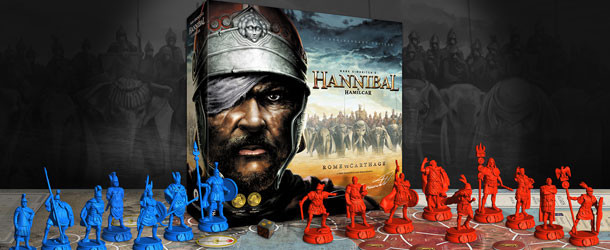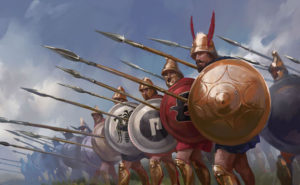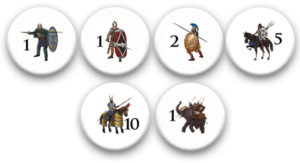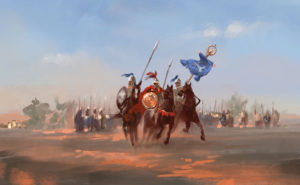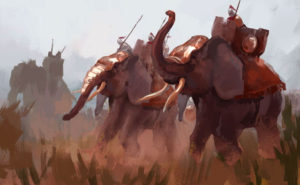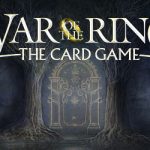While you are waiting to play your first game of Hannibal & Hamilcar: Rome vs Carthage, let’s learn more about the army of Carthage.
Once again, the game designer and veteran wargamer, Dariusz Góralski provided the PHALANX team with historical guidance (as he did for the Roman army, discussed in the past article) and we must thank him for his efforts and valuable lessons about the portrayal of armies in Hannibal & Hamilcar.
Carthage was a great ancient civilization, which, like Rome, conquered a sizable part of the Mediterranean area. During the second half of the 1st millennium BC, Carthage was the most dangerous enemy of Rome. The climax of the conflict between these two ancient superpowers was the Punic Wars. Most of you probably know that these wars ended in the complete defeat and utter destruction of Carthage. As a result, most of the historical knowledge of Carthage was made available to the world by Roman sources.
The Carthaginian army from the Second Punic War resembled a Hellenistic army. It relied fully upon a commander, his experience, efficiency, and charisma. A Carthaginian army was only as strong as its leader. Hannibal’s strength lay in uniting military units, small numbers of militia, Libyan soldiers, and mercenaries of various origins.
Hellenistic armies provided various possibilities. The commander of such an army had at his disposal a number of units armed and trained properly for one given task. These units were perfectly prepared, but for one specialized thing only. How they were to be used depended entirely on the creativity of the Hellenistic commander. It was a kind of variation on the rock-paper-scissors game, and for a long time the Romans knew only how to form a rock…
Hannibal’s strength wasn’t attributed solely to the perfect use of his own units’ diversity and capabilities. According to scholars, he might have learned from Hispanic Celts how to prepare ambushes. Such an ambush could mean hiding units on the battlefield (e.g. Battle of the Trebbia), or perhaps even an entire army (e.g. Battle of Lake Trasimene). Ambushes could also be the result of secret river crossings that were designed to surprise the enemy or distract their attention. Hannibal knew that consuls were often overconfident, and that the Roman army had poor scouts (weak cavalry). It would have been a shame not to seize such an opportunity.
Most scholars lean towards the idea that units consisting purely of Carthaginians were armed in the manner of late hoplites, meaning Hellenic helmets, linothoraxes or leather armor, round or oval shields, swords, and spears (perhaps 3 meters long). Libyan units are similarly described. This sedentary, agricultural people (related to the Numidians and Moors) settled lands around Carthage. The Libyans displayed exceptional tenacity, resilience to hardship, and extraordinary fortitude. That’s why a Libyan infantry unit, of all the Carthaginian ones, is displayed on the Carthaginian Combat Unit piece – in recognition of their achievements and the fact that they had always constituted the core of Carthaginian forces.
According to Roman sources, many of the Libyan infantry soldiers - as a consequence of the first battles against Romans - armed themselves with Roman weapons. Scholars are sometimes doubtful of this, though, as the Roman armament was best suited for the manipular system, not dense hoplite phalanxes. Perhaps this belief originated in the fact that a considerable number of Libyan soldiers possibly dressed as Romans to prepare an ambush at the Battle of Cannae. According to the respectable Ardant du Picq, the disguised Libyan units deceived the center of the Roman forces, flanked and struck them, thus intensifying havoc among the Romans.
Besides heavy infantry, the Libyans provided excellent spear-hurling light units called lonchophoroi. It is also worth noting that the Libyans furnished the Carthaginian cavalry with contingents of long-spear armed cavalry. Such contingents were also provided by Liby-Phoenicians – a people related to Carthaginians linguistically and religiously, although lacking Carthaginian civil rights. Their heavy cavalry used helmets, Hellenic armor, and long spears. The Libyan infantry constituted the core of the Carthaginian forces. The rest of the Carthaginian infantry consisted of contingents of allies and mercenaries of all sorts.
Carthage was also known for its extensive use of mercenary units (who for the most part weren’t mercenaries in the strictest meaning of the word, but more like subject units from territories that Carthage had conquered or allied with). Apart from the impressively diverse Libyans and well trained Liby-Phoenicians and Carthaginians, other countries provided Hannibal with packs of warriors, who over time became the soldiers of Hannibal’s own army: Iberians, Italians, Celts (Gauls), Balearic slingers, Greeks, and Punics.
Iberians were the heavy infantry. Armed with javelins, long shields and falcatas (short swords), they fought in a phalanx. Italian units from Campania and Sardinia, as well as Gauls, used their own native equipment. Balearic slingers were a deadly-accurate force who could strike their enemies from even 200 meters! And, of course, there were elephants. Hannibal made use of them only a few times (e.g. the Trebbia) because they had mostly died during the crossing through the Alps. But elephants were very dangerous, they could easily break through enemy formations, and they crushed morale. Another important force in the army of Hannibal was the cavalry: Libyan, Iberian Celtic, Hispanic, and others. In many battles they played a very important role and were far superior to the Roman cavalry.
All this contributed to the fact that Hannibal not only had to be a general who gave out orders, he also had to connect his army and possess extensive knowledge about each and every unit’s strength and weakness. In comparison to the standard and uniform Roman manipular system, Hannibal had to be flexible and adapt to changing conditions. He had to shape his army, apply tactics, and govern drastically different ethnic groups under one banner. It is known that he learned through his war experience and applied his knowledge during many battles. There is no doubt that Hannibal was in fact one of the greatest generals of all time.
The underrated “hero” of this army was the Hellenistic phalanx: a shield wall with a mass of spear points, supported by the mad Celts and gloomy Iberians. It was the phalanx which was the core of the army. It could not win by itself, but ensured the possibility of victory. A coin representing infantry, Libyan infantry, or perhaps Carthaginian African infantry (accurate for the late phase of the Second Punic War) is the best representation of the Carthaginian army. The Carthaginian cavalry won battles, but it was the resistance of its infantry, along with its resilience to Roman attacks in the front, that was decisive.
The next – and last - preview article will present the two expansionsreleasing together with the base game: Sun of Macedon and Price of Failure. Stay tuned!
See also:

